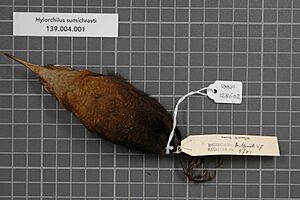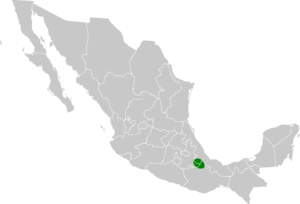Sumichrast's wren facts for kids
Quick facts for kids Sumichrast's wren |
|
|---|---|
 |
|
| Conservation status | |
| Scientific classification | |
| Genus: |
Hylorchilus
|
| Species: |
sumichrasti
|
 |
|
Sumichrast's wren is a small bird also known as the slender-billed wren. Its scientific name is Hylorchilus sumichrasti. This bird belongs to the wren family, called Troglodytidae. It lives only in Mexico, meaning it is endemic to that country.
Contents
About the Sumichrast's Wren Name
This bird is named after a Mexican scientist named François Sumichrast. He was a naturalist, someone who studies nature.
Scientists once thought there was a different type of Sumichrast's wren. This was called Hylorchilus sumichrasti navai. But in the 1990s, they decided it was a separate species. Now it is known as Nava's wren.
What Does Sumichrast's Wren Look Like?
Sumichrast's wren is about 15 to 16.5 centimeters (6 to 6.5 inches) long. A female bird was found to weigh about 28.4 grams (1 ounce).
Adult wrens have dark brown feathers on their heads, necks, and backs. Their lower backs are a sooty brown color. Their chin and throat are a light tan color. This color gets deeper on their chest, sides, and belly. The chest has faint dark lines, and the belly has tiny white dots.
Young wrens look similar to adults. However, their throats might look a bit dirty. They also have faint dark marks. Their lower parts are darker, and the markings on their chest and belly are lighter.
Where Do Sumichrast's Wrens Live?
Sumichrast's wren lives in a small part of Mexico. You can find it from central Veracruz to northern Oaxaca.
This bird likes to live in the lower parts of humid forests. These can be forests that stay green all year or those that lose some leaves. They also live in shady coffee farms. However, they only live in places with lots of limestone rocks sticking out of the ground. They can be found from 75 to 1,000 meters (246 to 3,280 feet) above sea level.
How Sumichrast's Wrens Behave
What Sumichrast's Wrens Eat
Sumichrast's wrens mostly eat small creatures without backbones. These include arthropods like insects and spiders. They also eat snails and worms. Sometimes, they will eat a small fruit.
They look for food on or very close to the ground. They hop around and make short flights. They use their beaks to poke into cracks and holes to find prey. Sometimes, they will quickly catch a flying insect that passes by.
Reproduction and Nests
Scientists have found active Sumichrast's wren nests in May. The nest is shaped like a cup. It is made from grass, roots, and other plant materials. These birds build their nests inside caves or in cracks in rocks.
Both the male and female wrens gather materials for the nest. But only the female bird builds the nest itself. A female usually lays three eggs. The male bird brings food to the female while she is sitting on the eggs. Once the baby birds hatch, both parents bring food to them.
Sumichrast's Wren Sounds
Male Sumichrast's wrens sing a special song. It is a series of loud, rich whistles that go down in pitch. You can hear an example of their song here.
Female wrens sing a simpler song. It is a short phrase with one sound repeated over and over. They also make different calls. One of their calls can be heard here.
Protecting Sumichrast's Wren
The IUCN (International Union for Conservation of Nature) has said that Sumichrast's wren is "Near Threatened." This means the bird could become endangered in the future.
This species lives in a small area and does not have a very large population. Both the area where they live and their numbers are likely shrinking. This is happening because their habitat (the place where they live) is being lost or damaged.


